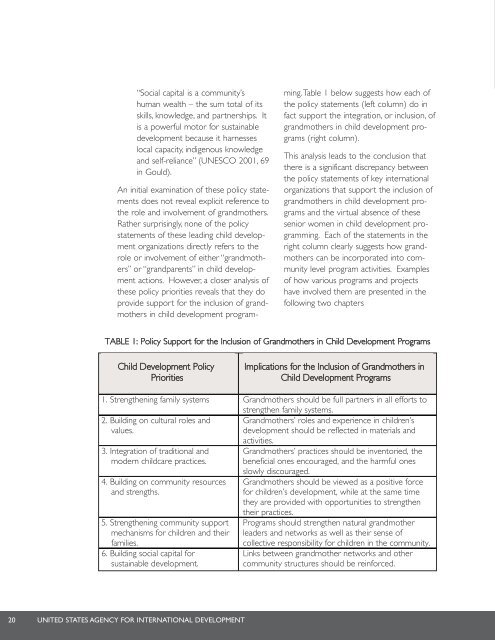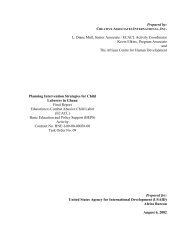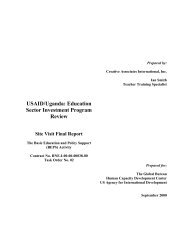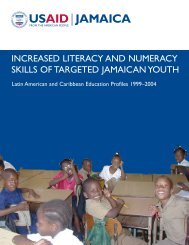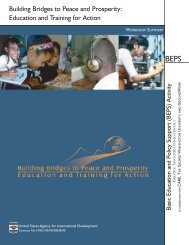“Social capital is a community’shuman wealth – the sum total of itsskills, knowledge, <strong>and</strong> partnerships. Itis a powerful motor for sustainabledevelopment because it harnesseslocal capacity, indigenous knowledge<strong>and</strong> self-reliance” (UNESCO 2001, 69in Gould).An initial examination of these policy statementsdoes not reveal explicit reference tothe role <strong>and</strong> involvement of gr<strong>and</strong>mothers.Rather surprisingly, none of the policystatements of these leading child developmentorganizations directly refers to therole or involvement of either “gr<strong>and</strong>mothers”or “gr<strong>and</strong>parents” in child developmentactions. However, a closer analysis ofthese policy priorities reveals that they doprovide support for the inclusion of gr<strong>and</strong>mothersin child development programming.Table1 below suggests how each ofthe policy statements (left column) do infact support the integration, or inclusion, ofgr<strong>and</strong>mothers in child development programs(right column).This analysis leads to the conclusion thatthere is a significant discrepancy betweenthe policy statements of key internationalorganizations that support the inclusion ofgr<strong>and</strong>mothers in child development programs<strong>and</strong> the virtual absence of thesesenior women in child development programming.Each of the statements in theright column clearly suggests how gr<strong>and</strong>motherscan be incorporated into communitylevel program activities. Examplesof how various programs <strong>and</strong> projectshave involved them are presented in thefollowing two chaptersTABLE 1: <strong>Policy</strong> Support for the Inclusion of <strong>Gr<strong>and</strong>mothers</strong> in Child Development ProgramsChild Development <strong>Policy</strong>PrioritiesImplications for the Inclusion of <strong>Gr<strong>and</strong>mothers</strong> inChild Development Programs1. Strengthening family systems <strong>Gr<strong>and</strong>mothers</strong> should be full partners in all efforts tostrengthen family systems.2. Building on cultural roles <strong>and</strong> <strong>Gr<strong>and</strong>mothers</strong>’ roles <strong>and</strong> experience in children’svalues.development should be reflected in materials <strong>and</strong>activities.3. Integration of traditional <strong>and</strong> <strong>Gr<strong>and</strong>mothers</strong>’ practices should be inventoried, themodern childcare practices. beneficial ones encouraged, <strong>and</strong> the harmful onesslowly discouraged.4. Building on community resources <strong>Gr<strong>and</strong>mothers</strong> should be viewed as a positive force<strong>and</strong> strengths.for children’s development, while at the same timethey are provided with opportunities to strengthentheir practices.5. Strengthening community support Programs should strengthen natural gr<strong>and</strong>mothermechanisms for children <strong>and</strong> their leaders <strong>and</strong> networks as well as their sense offamilies.collective responsibility for children in the community.6. Building social capital for Links between gr<strong>and</strong>mother networks <strong>and</strong> othersustainable development.community structures should be reinforced.20 UNITED STATES AGENCY FOR INTERNATIONAL DEVELOPMENT
III. HOW HAVE CHILD DEVELOPMENTPROGRAMS INVOLVED GRANDMOTHERS?“With age comes experience <strong>and</strong> wisdom. <strong>Gr<strong>and</strong>mothers</strong> are themain resource persons for all matters related to thewell-being of women <strong>and</strong> children.”Community Leader,MaliThis chapter aims to answer thequestion,“To what extent do programsthat promote children’sdevelopment view gr<strong>and</strong>mothers as aresource, involve them in community programs,<strong>and</strong> capitalize on their experience<strong>and</strong> commitment?” Here, programs thathave explicitly involved gr<strong>and</strong>mothers,referred to as gr<strong>and</strong>mother-inclusive programs,are reviewed.PROGRAMS INVOLVINGGRANDMOTHERSAn extensive search was carried out, basedon the published literature, on informationabout the programs of numerous developmentagencies involved in children’s development,on the gray literature to whichthe author had access, as well as on informationfrom multiple key informants. Theresults of this review support the conclusionthat at a global level, in the areas ofECD, basic education, maternal <strong>and</strong> childhealth <strong>and</strong> nutrition, <strong>and</strong> HIV/AIDS thereare very few programs that have explicitlyinvolved gr<strong>and</strong>mothers. Alternatively, involvinggr<strong>and</strong>mothers in development strategiesproduces benefits for all generations.This assertion is illustrated in the briefdescriptions of gr<strong>and</strong>mother-inclusive projects(below), <strong>and</strong> in the more detaileddescription in Chapter IV of work in Malisupported by Helen Keller International(HKI).The projects identified are presented hereby topical area: early childhood development<strong>and</strong> primary education, newbornhealth, child nutrition, HIV/AIDS, <strong>and</strong>maternal <strong>and</strong> child health. For each ofthese projects/activities a brief descriptionis provided that includes, whenever possible,information on how gr<strong>and</strong>mothershave actually been involved in the childdevelopment activities, whether the gr<strong>and</strong>mothers’role is reflected in educational,communication, <strong>and</strong> training materials, <strong>and</strong>the results of their involvement for children,other family <strong>and</strong> community members,<strong>and</strong> for themselves. Given that thedocumentation on the identified experiencesis often limited, it was usually notpossible to collect information on all ofthese parameters.EARLY CHILDHOODDEVELOPMENT ANDPRIMARY EDUCATIONBOLIVIAA nutrition education booklet based ongr<strong>and</strong>mothers’ advice.GRANDMOTHERS:THE LEARNING INSTITUTION21
- Page 1 and 2: GRANDMOTHERS:A LEARNING INSTITUTION
- Page 3: GRANDMOTHERS:A LEARNING INSTITUTION
- Page 11 and 12: EXECUTIVE SUMMARYSociety itself fai
- Page 13 and 14: Education, the Bernard Van LeerFoun
- Page 15 and 16: SEVERAL FACTORS CONTRIBUTE TO THELI
- Page 17: - Who am I? Assign children to askf
- Page 20 and 21: in educational activities on home t
- Page 22 and 23: “A grandmother’s understandingo
- Page 24 and 25: “Culture tells peoplehow to view
- Page 26 and 27: attention given to grandmothers’
- Page 28 and 29: social work, including family syste
- Page 30 and 31: mation from Azerbaijan (McNulty 200
- Page 32 and 33: “The status of eldersin tradition
- Page 34 and 35: “As women, thegrandmothers haveli
- Page 36 and 37: members often consult the moreexper
- Page 40 and 41: In a collaborative effort between
- Page 42 and 43: in-laws and the additional free tim
- Page 44 and 45: "Involving grandmothersin community
- Page 50 and 51: CULTURALLY-ADAPTED EDUCATIONMATERIA
- Page 52 and 53: strated the power of participatory
- Page 54 and 55: effects of the new ideas, their con
- Page 57 and 58: V. GRANDMOTHERS: A LEARNING INSTITU
- Page 59 and 60: Many health and development workers
- Page 61 and 62: VI. RECOMMENDATIONS FORBASIC EDUCAT
- Page 63 and 64: parents themselves did not go to sc
- Page 65 and 66: community ties by increasing teache
- Page 67 and 68: of millions. On the other hand, som
- Page 69: teachers, teacher abuse of children
- Page 73 and 74: APPENDIX B:ANNOTATEDREFERENCES ON T
- Page 75 and 76: acceptable for younger women to mak
- Page 77 and 78: showed that men are not directly in
- Page 79 and 80: ecause they had more time to devote
- Page 81 and 82: matrilineal or patrilineal areas
- Page 83 and 84: diet, work, fetal development, sexu
- Page 85 and 86: in the family and social networks.
- Page 87 and 88: elated, for example, to early child
- Page 89 and 90:
REFERENCESAdams, A. M., S. Madhavan
- Page 91 and 92:
BASICS and LINKAGES. 1998. Influenc
- Page 93 and 94:
Childhood Education and Development
- Page 95 and 96:
Krishna, A. and N. Uphoff. June 199
- Page 97 and 98:
Sear, R., R. Mace, and I. A. McGreg
- Page 99 and 100:
ABOUT THE AUTHORThis review was pre


